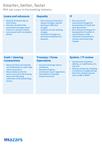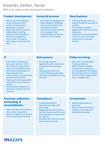
How RPA can facilitate digital transformation in financial services
The drive to digitise products and services is putting extra strain on back office departments, which are under pressure to speed up automation and increase their cost-efficiency. Robotic process automation (RPA) can play a vital role in helping them to do this and enabling organisations to survive and thrive, despite the challenging circumstances we find ourselves in.
Why RPA makes sense for financial services
- Back office inefficiency: Complex products and processes mean that the financial services industry still relies heavily on back office departments to process requests, set up, change and approve products. Managing these processes manually is extremely inefficient and costly and with numerous new fintech businesses entering the market, traditional incumbents are facing intense competition. Automating more of these processes through RPA is therefore becoming a business necessity.
- A shift to digital while keeping cost-effective physical branches: Customers are demanding more seamless digital experiences, while banks are under pressure to rationalise the number of high street branches and maximise front-office employees for value-added tasks.
- Working with legacy systems: Both banks and insurance companies have a track record of gradually layering new platforms on top of each other, while delaying the replacement of core systems. This leads to a complex IT architecture and legacy systems that are expensive and time-consuming to modify.
- Younger generations demand more engaging work: Younger generations of digital-savvy employees are demanding more meaning at work and are less willing to perform manual, mundane tasks. Instead, they want to work on value-add activities where they can feel like they’re making a difference. Automation is a key part of facilitating this shift.
Typical RPA applications
RPA is best suited to delivering improvements in repetitive activities with high processing volumes. For example, in insurance cancellation requests, or the creation of bank accounts for new mortgage clients. In these situations, the automated process would look something like this:
Insurance cancellation
- The broker sends information about insurance to be cancelled via an email form
- A robot validates the input, logs into the core system and completes the cancellation using the system
- The robot informs the broker about the successful cancellation
Creation of bank accounts for mortgage clients
- A mortgage is approved by a loan approval system
- A robot checks for newly approved mortgages
- For each new mortgage, the robot creates an account in the core banking system
- The robot updates the loan application system and inputs the bank account reference number
For a full overview of processes that are ideal for automation, please click on the documents below.
Benefits of RPA
Implementing RPA has two key benefits over other IT implementations:
- Avoiding expensive integrations
As most systems in banks and insurance companies need to be interconnected and able to ‘talk’ to each other, even small changes can impact the whole ecosystem. In this environment, RPA is a great fit as it does not require integration and can automate any functionality of the existing user interface without involving the vendor, and while keeping all front-end validations in place. - Shorter time to market
With competition in financial services intensifying, organisations are under pressure to release regular product updates and innovations, in order to stay relevant. And while more traditional systems can be slow to develop, RPA makes product updates much faster, as it can be deployed within a couple of weeks, due to reduced time contacting vendors, running system integration tests and train back-office employees, for example.
Next steps for RPA
- Get internal buy-in: Make sure your leadership team understands the benefits of RPA and where it can be applied in the business.
- Find an external partner: By selecting a partner you trust, who has experience with RPA, you can significantly speed up your RPA journey.
- Build a business case: Collect quantitative and qualitative data on existing processes, to prioritise those with the highest potential for savings. Run opportunity assessment exercises across a couple of departments to identify opportunities for automation.
- Set up governance: Define key roles, processes, KPIs and monitor delivery.
- Scale up: Continuously assess opportunities for automation and stay up to date with the latest technology that can drive efficiency savings.
For more information or to talk about how RPA can help your business, please get in touch with us below.
This article was written by Martin Vaross, Partner at Mazars, and Rudolf Vido, Manager at Mazars.



